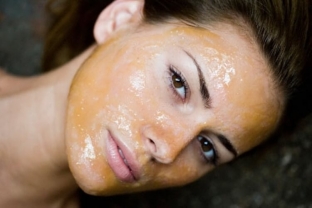Chemical peels, due to their high efficiency, have long earned popularity all over the world. In our country, they have become widely used relatively recently, but some of them have already become an integral part of the life of modern women. Just a few procedures make it possible not only to cleanse the skin and significantly improve its appearance, but also to achieve a fairly pronounced effect of rejuvenation. One of the popular and especially effective types of peeling is yellow or retinol peeling, which estet-portal.com talks about today. This effective procedure makes it possible to act on the skin, significantly improving its properties.
Efficiency and features of retinol peeling
Retinol peeling belongs to the category of rejuvenating treatments that affect the surface and middle layers of the skin. Retinol products gently affect the dermis, while not irritating or injuring the skin. The main active ingredient of yellow peeling is vitamin A or retinol. In addition, the peel contains ascorbic, azelaic, phytic and kojic acids, which prevent skin pigmentation.
The retinol peeling procedure improves the blood supply to skin cells, promotes epidermis renewal and active protein production.
This type of chemical peel can be recommended for people of any age, even young patients, as a treatment for post-acne.
Retinol Peel:
• retinol peeling: indications and contraindications for the procedure;
• the main stages of retinol peeling;
• what results can be achieved with retinol peeling.
Retinol peeling: indications and contraindications for the procedure
Retinol peeling is most suitable for patients who do not want to undergo a long rehabilitation process after the procedure and want to get a quick result without wasting time. Yellow peeling may be indicated in the following cases:
• for the prevention of aging;
• to remove age spots;
• with atonicity of the skin;
• to eliminate photoaging and mimic wrinkles;
• for the treatment of acne and its consequences;
• as a treatment for scars and keratomas.
Pregnancy and lactation, acute inflammatory processes on the skin, use of retinoids, liver disease, intolerance to the peeling components can serve as contraindications for retinol peeling.
The main stages of retinol peeling
To obtain the maximum effect of retinol peeling, it is necessary to strictly follow the staging of the process and recommendations at each stage of skin cleansing. Two weeks before the peeling, the patient should start using cosmetic products containing glycolic acid, or undergo a gentle fruit-acid peeling procedure. This is necessary to soften the stratum corneum, which will facilitate the penetration of the retinol peeling components into the skin. Immediately before the procedure, it is necessary to thoroughly clean the patient's skin from cosmetics and impurities, and treat it with a solution of salicylic and glycolic acids to remove dead epidermal cells. The peeling composition is applied to the skin and remains there for 15 to 60 minutes, depending on the concentration of the drug and the desired effect.

Immediately after the retinol peeling procedure, the patient can see a rejuvenating effect, but the maximum result is achieved after a full course of procedures, the duration of which is determined by the specialist individually for each patient.
After retinol peeling, the patient's skin becomes firm and smooth, fine wrinkles are absent and deep wrinkles are partially smoothed, the complexion becomes even, and skin defects are eliminated.In addition, retinol peeling helps to normalize the blood supply to the dermis, increase the production of elastin and collagen, and also improve metabolic processes in skin cells. The effectiveness of retinol peeling makes this procedure very popular among people of absolutely different ages, but the result is especially pronounced in patients who “came for rejuvenation”, because thanks to retinol peeling they will definitely get the desired result.







Add a comment